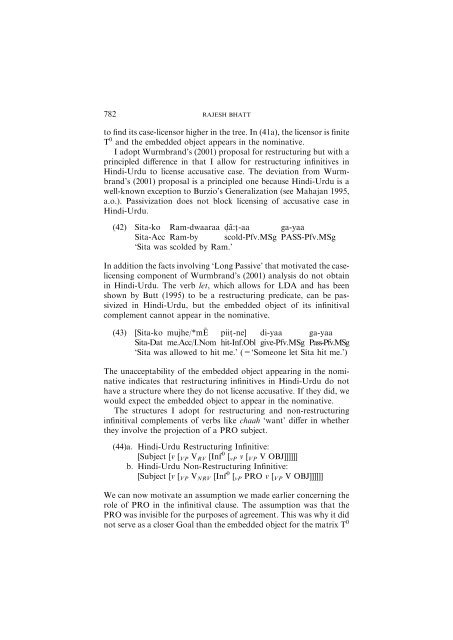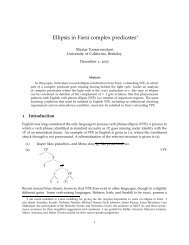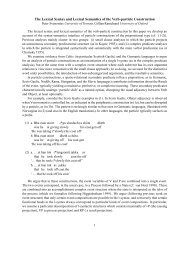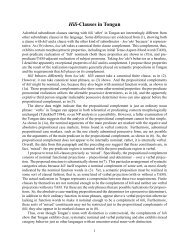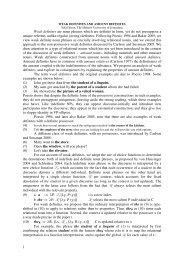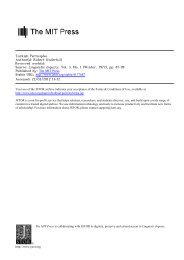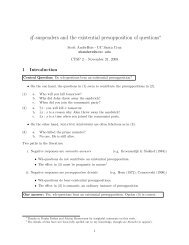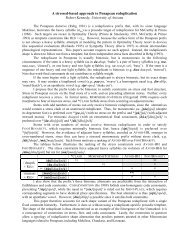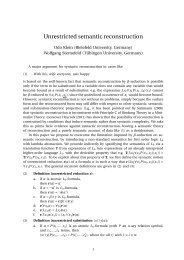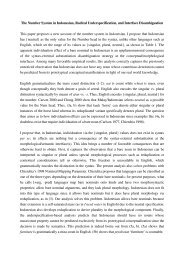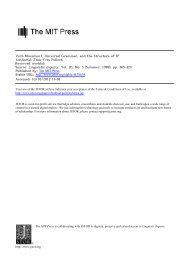LONG DISTANCE AGREEMENT IN HINDI-URDUw This paper ...
LONG DISTANCE AGREEMENT IN HINDI-URDUw This paper ...
LONG DISTANCE AGREEMENT IN HINDI-URDUw This paper ...
Create successful ePaper yourself
Turn your PDF publications into a flip-book with our unique Google optimized e-Paper software.
782RAJESH BHATTto find its case-licensor higher in the tree. In (41a), the licensor is finiteT 0 and the embedded object appears in the nominative.I adopt Wurmbrand’s (2001) proposal for restructuring but with aprincipled difference in that I allow for restructuring infinitives inHindi-Urdu to license accusative case. The deviation from Wurmbrand’s(2001) proposal is a principled one because Hindi-Urdu is awell-known exception to Burzio’s Generalization (see Mahajan 1995,a.o.). Passivization does not block licensing of accusative case inHindi-Urdu.(42) Sita-ko Ram-dwaaraa d:a˜ :t:-aa ga-yaaSita-Acc Ram-by scold-Pfv.MSg PASS-Pfv.MSg‘Sita was scolded by Ram.’In addition the facts involving ‘Long Passive’ that motivated the caselicensingcomponent of Wurmbrand’s (2001) analysis do not obtainin Hindi-Urdu. The verb let, which allows for LDA and has beenshown by Butt (1995) to be a restructuring predicate, can be passivizedin Hindi-Urdu, but the embedded object of its infinitivalcomplement cannot appear in the nominative.(43) [Sita-ko mujhe/*m~E piit:-ne] di-yaa ga-yaaSita-Dat me.Acc/I.Nom hit-Inf.Obl give-Pfv.MSg Pass-Pfv.MSg‘Sita was allowed to hit me.’ (=‘Someone let Sita hit me.’)The unacceptability of the embedded object appearing in the nominativeindicates that restructuring infinitives in Hindi-Urdu do nothave a structure where they do not license accusative. If they did, wewould expect the embedded object to appear in the nominative.The structures I adopt for restructuring and non-restructuringinfinitival complements of verbs like chaah ‘want’ differ in whetherthey involve the projection of a PRO subject.(44)a. Hindi-Urdu Restructuring Infinitive:[Subject [v [ VP V RV [Inf 0 [ vP v [ VP V OBJ]]]]]]b. Hindi-Urdu Non-Restructuring Infinitive:[Subject [v [ VP V NRV [Inf 0 [ vP PRO v [ VP V OBJ]]]]]]We can now motivate an assumption we made earlier concerning therole of PRO in the infinitival clause. The assumption was that thePRO was invisible for the purposes of agreement. <strong>This</strong> was why it didnot serve as a closer Goal than the embedded object for the matrix T 0


